
Advancing Orion Through Commercial Service Models for Future Lunar and Deep Space Exploration
The Orion spacecraft stands as humanity’s premier exploration-class vehicle — a unique spacecraft designed and built to carry astronauts farther than ever before. As the only crewed spacecraft capable of taking humans to the Moon, onward to Mars, and even deeper into the solar system, Orion represents both a technological milestone and a strategic asset for NASA’s Artemis program. With the highly anticipated Artemis II launch approaching — the third Orion flight and the first to carry a human crew — attention is turning toward ensuring the program’s long-term sustainability.
Lockheed Martin, Orion’s prime contractor, is actively exploring new operational models that can reduce costs, streamline processes, and enhance mission efficiency. Central to this initiative is the idea of transitioning Orion’s future missions toward a firm fixed-price, industry-led services model. Such a change, the company believes, could accelerate cost reductions and simplify operations through greater reliance on commercial oversight practices.
Moving Toward Orion as a Service
Preliminary studies, along with early discussions with industry partners and stakeholders, are already underway to examine the feasibility and requirements of offering “Orion as a Service.” This concept would shift significant operational responsibilities from NASA to the commercial sector, allowing industry to lead in areas where it can bring agility, efficiency, and proven cost controls.
Ultimately, the objective is to maintain Orion’s unparalleled safety and reliability standards while providing a more sustainable approach to lunar exploration. For NASA, this could mean sustaining Artemis missions over the long term without unsustainable budget pressures. For industry, it could unlock opportunities to innovate, invest in advanced space technologies, and pave the way for the next giant leap — sending humans to Mars.
“It’s clear to us that Artemis missions need to be more cost-effective and efficient,” explained Kirk Shireman, Lockheed Martin’s Vice President and Program Manager for Orion. “Industry needs to take steps to enable NASA to sustain Artemis, while investing in future deep space human exploration systems and technologies.”
A Phased Path to Commercial Services
The Fiscal Year 2026 President’s Budget Request proposes a deliberate transition toward commercial transportation services for later Artemis missions. The aim is to improve cost-effectiveness, increase mission cadence to the Moon, and encourage stronger industry leadership.
Lockheed Martin envisions a phased implementation. The initial stage would involve transferring infrastructure-focused tasks — such as crew module recovery after splashdown, post-mission de-servicing for quicker reuse, payload and cargo management, Orion fueling prior to launch, vehicle closeouts, and integration of the Launch Abort System — to commercial service providers. These activities are labor-intensive but require minimal new engineering and limited government oversight, making them well-suited to industry management.
The second stage would expand commercial responsibilities to the actual construction of future Orion spacecraft under a firm fixed-price contract. Eventually, the entire capability could be delivered as a full commercial service, similar to NASA’s Commercial Crew Program that currently supports the International Space Station.
Cost Reduction Already in Motion
The transition comes at a natural inflection point. With Artemis II, Orion’s capsule design work is largely complete, marking the end of the initial development contract. Spacecraft production for Artemis III and subsequent missions falls under the Orion production and operations contract, which already incorporates firm fixed-price terms in later missions.
Lockheed Martin has made measurable progress toward cost efficiency:
- Artemis V is projected to cost less than half of Artemis II.
- By Artemis VIII, additional savings of around 30% are expected.
Shireman emphasized that these reductions have been achieved without compromising Orion’s high standards of safety, performance, and mission readiness. Working closely with NASA and industry partners, Lockheed Martin is confident it can push costs even lower while maintaining — and even improving — mission capability.
Building on a Proven Track Record
Lockheed Martin’s confidence in this commercial shift is grounded in experience. Fixed-price contracts are not new territory; in fact, 60% of the company’s sales last year were under fixed-price agreements. The company has delivered numerous NASA programs as services offerings, including the Orion Exploration Flight Test-1 (EFT-1) mission, competitive commercial bids, and the recent Mars Sample Return proposal.
Lockheed Martin has also managed decades of cost-capped planetary missions, with some coming in under budget and returning funds to NASA. This history of delivering complex space projects efficiently makes the company well-positioned to scale commercial service models for Orion.
A Sustainable Future for Artemis and Beyond
By applying commercial best practices, leveraging fixed-price contract experience, and integrating lessons learned from decades of deep space missions, Lockheed Martin sees a clear path to making Artemis more financially sustainable. This approach would allow NASA to focus resources on future deep space exploration systems, accelerating technology development for eventual crewed missions to Mars.
In essence, Orion’s evolution into a commercially managed service could become one of the defining steps toward humanity’s sustained presence beyond Earth, ensuring that each Artemis mission is not just a historic event — but a stepping stone to the stars.




